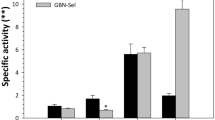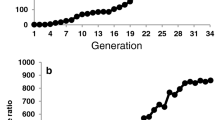Abstract
The tomato pinworm Tuta absoluta is currently the most important pest of tomatoes worldwide. Diamides are one of the few effective classes of insecticides in use for its management, but recent cases of very high resistance to these insecticides in field populations of this invasive pest species have been reported in Brazil and Europe. Herein, the resistance of T. absoluta to chlorantraniliprole was genetically and biochemically characterized. Concentration–mortality curves were estimated for parental (GBN-Sus and AMD-Sel), F1, and backcross generations through the leaf-dipping method, which was also used in further bioassay-based experiments. Inheritance studies indicated that chlorantraniliprole resistance is monogenic, completely recessive, and autosomal. Dominance of chlorantraniliprole resistance was concentration dependent shifting to recessive as the insecticide concentration increased. In addition, concentrations above 0.4 mg chlorantraniliprole/L made resistance completely recessive. Esterases, glutathione S-transferases, and cytochrome P450-dependent monooxygenases are apparently not involved in the chlorantraniliprole resistance. Furthermore, the cross-resistance spectrum was restricted to the diamide insecticides flubendiamide and cyantraniliprole, suggesting that altered target site is the likely mechanism involved, in contrast with enhanced detoxification. Therefore, the interruption of chlorantraniliprole use against the tomato pinworm would be a useful management initiative for diamide resistance management for already resistant populations. Diamide use against this species in newly invaded areas should be carefully monitored to ascertain that diamide-resistant insects were not introduced and also to prevent rapid selection for diamide resistance and its potential spread to other areas.


Similar content being viewed by others
References
Abbott WS (1925) A method of computing the effectiveness of an insecticide. J Econ Entomol 18:265–267
Biondi A, Guedes RNC, Wan F-H, Desneux N (2018) Ecology, worldwide spread, and management of the invasive South American tomato pinworm, Tuta absoluta: past, present, and future. Annu Rev Entomol 63:239–258
Bourguet D, Genissel A, Raymond M (2000) Insecticide resistance and dominance levels. J Econ Entomol 93:1588–1595
Campos MR, Silva TBM, Silva WM, Silva JE, Siqueira HAA (2015a) Spinosyn resistance in the tomato borer Tuta absoluta (Meyrick) (Lepidoptera: Gelechiidae). J Pest Sci 88:405–412
Campos MR, Silva TBM, Silva WM, Silva JE, Siqueira HAA (2015b) Susceptibility of Tuta absoluta (Lepidoptera: Gelechiidae) Brazilian populations to ryanodine receptor modulators. Pest Manage Sci 71:537–544
Campos MR, Biondi A, Adiga A, Guedes RNC, Desneux N (2017) From the Western Palaeartic region to beyond: Tuta absoluta 10 years after invading Europe. J Pest Sci 90:787–796
Cordova D et al (2006) Anthranilic diamides: a new class of insecticides with a novel mode of action, ryanodine receptor activation. Pestic Biochem Physiol 84:196–214
Desneux N, Wajberg W, Wyckhuys KAG et al (2010) Biological invasion of European tomato crops by Tuta absoluta: ecology, geographic expansion and prospects for biological control. J Pest Sci 83:197–215
Desneux N, Luna MG, Guillemaud T, Urbaneja A (2011) The invasive South American tomato pinworm, Tuta absoluta, continues to spread in Afro-Eurasia and beyond: the new threat to tomato world production. J Pest Sci 84:403–408
Gontijo PC, Picanço MC, Pereira EJG, Martins JC, Chediak M, Guedes RNC (2013) Spatial and temporal variation in the control failure likelihood of the tomato leaf miner, Tuta absoluta. Ann Appl Biol 162:50–59
Guedes RNC (2017) Insecticide resistance, control failure likelihood and the First Law of Geography. Pest Manag Sci 73:479–484
Guedes RNC, Picanço MC (2012) The tomato borer Tuta absoluta in South America: pest, status, management and insecticide resistance. Bull OEPP/EPPO Bull 42:211–216
Guedes RNC, Siqueira HAA (2012) The tomato borer Tuta absoluta: insecticide resistance and control failure. CAB Rev Perspect Agric Vet Sci Nutr Nat Resources 7:1–7
Guedes RNC, Picanco MC, Matioli AL, Rocha DM (1994) Efeito de inseticidas e sistemas de condução do tomateiro no controle de Scrobipalpuloides absoluta (Meyrick) (Lepidoptera: Gelechiidae). An Soc Entomol Bras 23:321–325
Habig WH, Pabst MJ, Jakoby WB (1974) Glutathione S-transferases. The first enzymatic step in mercapturic acid formation. J Biol Chem 249:7130–7139
Hannig GT, Ziegler M, Marçon PG (2009) Feeding cessation effects of chlorantraniliprole, a new anthranilic diamide insecticide, in comparison with several insecticides in distinct chemical classes and mode-of-action groups. Pest Manag Sci 65:969–974
IRAC (2016) IRAC mode of action classification scheme. IRAC International Workgroup. http://www.irac-online.org/content/uploads/MoA-classification.pdf. Accessed 25 Aug 2016
Lahm GP et al (2005) Insecticidal anthranilic diamides: a new class of potent ryanodine receptor activators. Bioorg Med Chem Lett 15:4898–4906
Lahm GP et al (2007) Rynaxypyr™: a new insecticidal anthranilic diamide that acts as a potent and selective ryanodine receptor activator. Bioorg Med Chem Lett 17:6274–6279
Lahm GP, Cordova D, Barry JD (2009) New and selective ryanodine receptor activators for insect control. Biorg Med Chem 17:4127–4133
Lande R (1981) The minimum number of genes contributing to quantitative variation between and within populations. Genetics 99:541–553
Lehmann EL (1986) Testing statistical hypotheses, vol II. Springer Texts in Statistics, 2nd edn. Springer, New York
LeOra-Software (2005) POLO-Plus, POLO for Windows computer program, version 2.0. LeOra-Software, Petaluma
Liu X, Ning Y, Wang H, Wang K (2015) Cross-resistance, mode of inheritance, synergism, and fitness effects of cyantraniliprole resistance in Plutella xylostella. Entomol Exp Appl 157:271–278
Miota F et al (1998) Mechanisms of methyl and ethyl parathion resistance in the western corn rootworm (Coleoptera: Chrysomelidae). Pestic Biochem Physiol 61:39–52
Nauen R, Konanz S, Hirooka T, Nishimatsu T, Kodama H (2007) Flubendiamide: a unique tool in resistance management tactics for pest lepidoptera difficult to control. Pflanzenschutz-Nachr Bayer 60:247–262
Picanço MC, Guedes RNC (1999) Manejo Integrado de Pragas no Brasil: situação atual, problemas e perspectivas. Rev A Ambient 2:23–27
Robertson JL, Jones MM, Olguin E, Alberts B (2017) Bioassays with arthropods, 3rd edn. CRC Press Taylor & Francis Group, Boca Raton
Roditakis E, Skarmoutsou C, Staurakaki M (2013a) Toxicity of insecticides to populations of tomato borer Tuta absoluta (Meyrick) from Greece. Pest Manag Sci 69:834–840. https://doi.org/10.1002/ps.3442
Roditakis E, Skarmoutsou C, Staurakaki M et al (2013b) Determination of baseline susceptibility of European populations of Tuta absoluta (Meyrick) to indoxacarb and chlorantraniliprole using a novel dip bioassay method. Pest Manag Sci 69:217–227. https://doi.org/10.1002/ps.3404
Roditakis E, Vasakis E, Grispou M, Stavrakaki M, Nauen R, Gravouil M, Bassi A (2015) First report of Tuta absoluta resistance to diamide insecticides. J Pest Sci 88:9–16
Roditakis E et al (2017) Ryanodine receptor point mutations confer diamide insecticide resistance in tomato leafminer, Tuta absoluta (Lepidoptera: Gelechiidae). Insect Biochem Mol Biol 80:11–20
Roditakis E et al (2018) A four-year survey on insecticide resistance and likelihood of chemical control failure for tomato leaf miner Tuta absoluta in the European/Asian region. J Pest Sci 91:421–435
Rose RL, Brindley WA (1985) An evaluation of the role of oxidative enzymes in Colorado potato beetle resistance to carbamate insecticides. Pestic Biochem Physiol 23:74–84
Salazar ES, Araya JE (1997) Detección de resistência a inseticidas em la polilla del tomate. Simiente 67:8–22
Salazar ER, Araya JE (2001) Respuesta de la polilla del tomate, Tuta absoluta (Meyrick), a insecticidas en Arica. Agric Téc 61:429–435
SAS Institute (2001) SAS user’s guide: statistics, version 8.2. SAS Institute, Cary, NC
Silva GA, Picanco MC, Bacci L, Crespo ALB, Rosado JF, Guedes RNC (2011) Control failure likelihood and spatial dependence of insecticide resistance in the tomato pinworm, Tuta absoluta. Pest Manag Sci 67:913–920
Silva WM, Berger M, Bass C, Balbino VQ, Amaral MHP, Campos MR, Siqueira HAA (2015) Status of pyrethroid resistance and mechanisms in Brazilian populations of Tuta absoluta. Pestic Biochem Physiol 122:8–14
Silva JE, Assis CPO, Ribeiro LMS, Siqueira HAA (2016a) Field-evolved resistance and cross-resistance of Brazilian Tuta absoluta (Lepidoptera: Gelechiidae) populations to diamide insecticides. J Econ Entomol 109:2190–2195
Silva TBM, Silva WM, Campos MR, Silva JE, Ribeiro LMS, Siqueira HAA (2016b) Susceptibility levels of Tuta absoluta (Meyrick) (Lepidoptera: Gelechiidae) to minor classes of insecticides in Brazil. Crop Protect 79:80–86
Siqueira HAA, Guedes RNC, Picanco MC (2000a) Insecticide resistance in populations of Tuta absoluta (Lepidoptera: Gelechiidae). Agric For Entomol 2:147–153
Siqueira HAA, Guedes RNC, Picanco MC (2000b) Cartap resistance and synergism in populations of Tuta absoluta (Lep., Gelechiidae). J Appl Entomol 124:233–238
Siqueira HAA, Guedes RNC, Fragoso DB, Magalhaes LC (2001) Abamectin resistance and synergism in Brazilian populations of Tuta absoluta (Meyrick) (Lepidoptera: Gelechiidae). Int J Pest Manage 47:247–251
Smith PK et al (1985) Measurement of protein using bicinchoninic acid. Anal Biochem 150:76–85
Steinbach D, Gutbrod O, Lümmen P, Matthiesen S, Schorn C, Nauen R (2015) Geographic spread, genetics and functional characteristics of ryanodine receptor based target-site resistance to diamide insecticides in diamondback moth, Plutella xylostella. Insect Biochem Mol Biol 63:14–22
Stone BF (1968) A formula for determining degree of dominance in cases of monofactorial inheritance of resistance to chemicals. Bull WHO 38:325–326
Tabashnik BE (1991) Determining the mode of inheritance of pesticide resistance with backcross experiments. J Econ Entomol 84:703–712
Troczka B et al (2012) Resistance to diamide insecticides in diamondback moth, Plutella xylostella (Lepidoptera: Plutellidae) is associated with a mutation in the membrane-spanning domain of the ryanodine receptor. Insect Biochem Mol Biol 42:873–880
Troczka BJ, Williams AJ, Williamson MS, Field LM, Lüemmen P, Davies TGE (2015) Stable expression and functional characterisation of the diamondback moth ryanodine receptor G4946E variant conferring resistance to diamide insecticides. Sci Rep 5:14680
van Asperen K (1962) A study of housefly esterases by means of a sensitive colorimetric method. J Insect Physiol 8:401–416
Zhou X, Scharf ME, Sarath G, Meinke LJ, Chandler LD, Siegfried BD (2004) Partial purification and characterization of a methyl-parathion resistance-associated general esterase in Diabrotica virgifera virgifera (Coleoptera: Chrysomelidae). Pestic Biochem Physiol 78:114–125
Acknowledgements
CAPES (for providing the Studentship to first author) and CNPq (for supporting HAAS with a fellowship #308461/2013-4) financially supported this research study.
Funding
This study was funded by the National Council for Scientific and Technological Development—CNPq (PROC 308461/2013-4).
Author information
Authors and Affiliations
Corresponding author
Ethics declarations
Conflict of interest
All authors declare that they have no conflict of interest.
Ethical approval
This article does not contain any studies with human participants or animals performed by any of the authors.
Additional information
Communicated by A. Biondi and Nicolas Desneux.
Special Issue on Advances in the Management of Tuta absoluta.
Electronic supplementary material
Below is the link to the electronic supplementary material.
Rights and permissions
About this article
Cite this article
Silva, J.E., Ribeiro, L.M.S., Vinasco, N. et al. Field-evolved resistance to chlorantraniliprole in the tomato pinworm Tuta absoluta: inheritance, cross-resistance profile, and metabolism. J Pest Sci 92, 1421–1431 (2019). https://doi.org/10.1007/s10340-018-1064-z
Received:
Revised:
Accepted:
Published:
Issue Date:
DOI: https://doi.org/10.1007/s10340-018-1064-z




